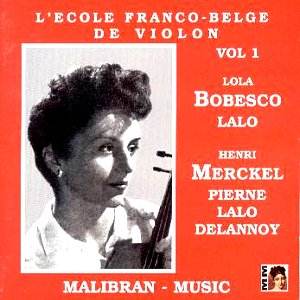This was the first volume to be issued in Malibran’s
Franco-Belgian Violin School series devoted here to two artists
who flourished into the LP era (and in Bobesco’s case beyond into
CD; she is still active I believe). This makes a particularly
interesting conjunction because Bobesco followed Enescu’s path
– Romanian born, French trained – whilst Merckel is more squarely
in the French tradition. Bobesco was born in Craiova in 1921,
a prizewinner at thirteen and an entrant in the Ysaye competition
of 1937. Her sonata partnership with Jacques Genty was long lasting,
as was her leadership of the Ensemble d’Archet Eugène Ysaye,
a position she held concurrently with her professorship at the
Brussels Conservatoire. She was also the first violin of a fine
quartet, which recorded some valuable CDs.
Merckel is one of those French violinists – I
think of Bouillon as well in this respect - whose sterling musicianship
remained broadly for home consumption. Of course he is closely
associated with the native repertoire of which he was such a splendid
exponent, as this disc so amply shows, and if he wasn’t a serious
competitor to his younger French colleague Ginette Neveu it should
be remembered that he was a slightly older contemporary of Francescatti
– and one who took discographic chances with the repertoire in
a way that the more internationally cosmopolitan Francescatti
didn’t. He was above all a frequently marvellous and idiomatic
interpreter of the repertoire and we have some choice examples
to tempt the ear here. So let’s start with him.
His 1946 recording of Pierné’s Impressions
de Music-Hall is full of joyful Gallic wit. Better known,
of course, as a conductor Pierné mined a particularly naughty
vein of popular French music, serving it up in a piquant sauce.
Pugnet-Caillard is similarly engaged in her piano part as the
composer takes us on a brisk scenic tour; the way Merckel coarsens
his pure tone is especially funny – almost as funny as the half
drunken parlando act he essays with such – which makes it all
the better – aristocratic finesse. The Impressions are in the
expected three "movements" – the second of which shows
us the more sentimental side of the Halls, with some impressionistic
blossom and bloom and wistfulness before the final Act which opens
with see-saw vigour to banish torpor and mist. Merckel digs deep
into his eyebrow arching lexicon faithfully to essay the whistles
and sawing fiddles asked of him. I defy you to resist the lugubrious
drunk act which so self pityingly follows, introduced by the ominous
bass in the piano part, with the violin swaying about precariously
until some pulsating virtuosity leads us triumphantly to a close.
Next comes the Intermezzo from Lalo’s Concerto Russe –
truly vital and lively playing if with a slightly metallic edge
to his tone - and the two pieces by Honegger pupil Marcel Delannoy.
The first is the Serenade Concertante, a short work in three movements.
The first, an Allegro, is delightfully verdant and appealing with
little Delian touches flecking the score. The second, an Andante,
floats a delicious series of melodies with wind counterpoint before
growing ever more meltingly affecting in the solo line, songful,
rapturous, only enhanced by Merckel’s aristocratically restrained
but utterly sweet tone. The Capriccio finale is brisk and jovial,
with the solo trumpet imparting a cocksure dance band certainty
to the brew before some little orchestral reminiscences surge
onto a joyful conclusion. The Danse des négrillons
from his ballet La Pantoufle de vair has a swaying rhythmic
finesse. Call it watered down La Création du Monde
if you will but the percussive taps, church bells chimes, violin
doubling the flute line, muted trumpet and exotic strings, impatient
cymbal clash and the like create an atmosphere that’s warm and
appealing.
Bobesco recorded the Symphonie espagnole in 1942
in Paris. She has a rather tense but not unappealing vibrato and
a nicely aerated style. Her trill is not electric but of reasonable
velocity and she employs it well in the Scherzando. She digs into
the chewy lower strings in the Intermezzo third movement (the
one routinely dropped by Russian players), sparing of portamento
– though when she has recourse to expressive devices such as this
she can be charismatic. After Bigot’s rather baleful opening to
the Andante Bobesco plays with well articulated and attractive
intelligence and though some of her phrasing in the Rondo finale
can sound a little smeary and artificial, one must keep in mind
that she was only twenty-one and however talented still at the
embryonic stage of her early career.
There are attractive period photographs of the
two fiddlers; I liked the no nonsense transfers and obviously
both the repertoire and the musicians are highly congenial to
me. In a sense it’s a shame that Merckel’s own recording of the
Symphonie espagnole wasn’t used – with the Pasdeloup Orchestra
and Coppola - as I don’t think it’s been reissued since and it
would have been a fitting tribute to this idiomatic and now forgotten
musician. But Bobesco makes a good companion and the disc pleased
me enormously. But then Malibran’s string releases always do.
Jonathan Woolf
